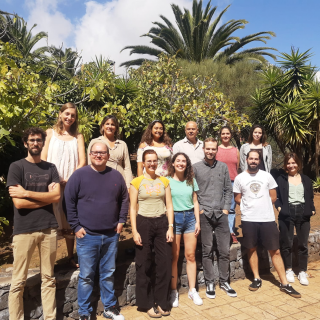Ardila, F.; Alatalo, Katherine; Lanz, Lauranne; Appleton, Philip N.; Beaton, Rachael L.; Bitsakis, Theodoros; Cales, Sabrina L.; Falcón-Barroso, J.; Kewley, Lisa J.; Medling, Anne M.; Mulchaey, John S.; Nyland, Kristina; Rich, Jeffrey A.; Urry, C. Meg
Bibliographical reference
The Astrophysical Journal, Volume 863, Issue 1, article id. 28, 10 pp. (2018).
Advertised on:
8
2018
Journal
Citations
10
Refereed citations
10
Description
The Shocked POststarburst Galaxy Survey (SPOGS) aims to identify
galaxies in the transitional phase between actively star-forming and
quiescence with nebular lines that are excited from shocks rather than
star formation processes. We explored the ultraviolet (UV) properties of
objects with near-ultraviolet (NUV) and far-ultraviolet (FUV) photometry
from archival GALEX data; 444 objects were detected in both bands, 365
in only the NUV, and 24 in only the FUV, for a total of 833 observed
objects. We compared SPOGs to samples of star-forming galaxies (SFs),
quiescent galaxies (Qs), classical E+A post-starburst galaxies, active
galactic nuclei (AGN) host galaxies, and interacting galaxies. We found
that SPOGs have a larger range in their FUV-NUV and NUV-r
colors compared with most of the other samples, although all of our
comparison samples occupied color space inside of the SPOGs region. On
the basis of their UV colors, SPOGs are a heterogeneous group, possibly
made up of a mixture of SFs, Qs, and/or AGN. Using Gaussian mixture
models, we are able to recreate the distribution of FUV-NUV colors
of SPOGs and E + A galaxies with different combinations of SFs, Qs, and
AGN. We find that the UV colors of SPOGs require a >60% contribution
from SFs, with either Qs or AGN representing the remaining contribution,
while UV colors of E + A galaxies required a significantly lower
fraction of SFs, supporting the idea that SPOGs are at an earlier point
in their transition from quiescent to star-forming than E + A galaxies.
Related projects

Traces of Galaxy Formation: Stellar populations, Dynamics and Morphology
We are a large, diverse, and very active research group aiming to provide a comprehensive picture for the formation of galaxies in the Universe. Rooted in detailed stellar population analysis, we are constantly exploring and developing new tools and ideas to understand how galaxies came to be what we now observe.
Anna
Ferré Mateu